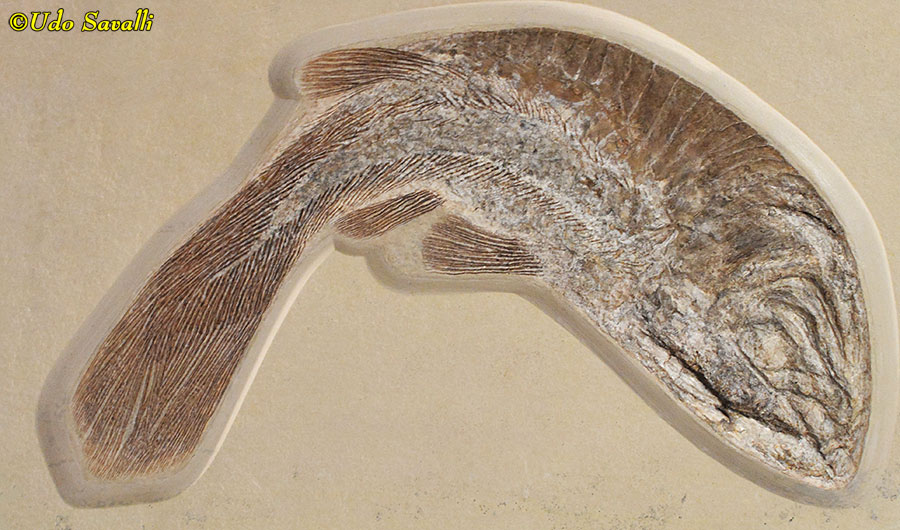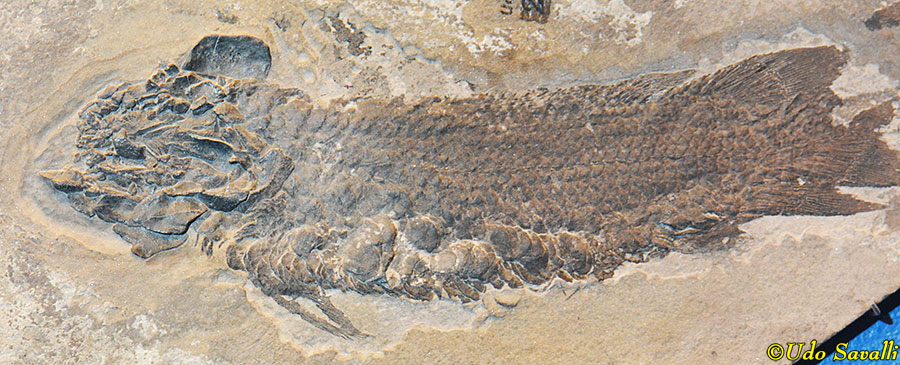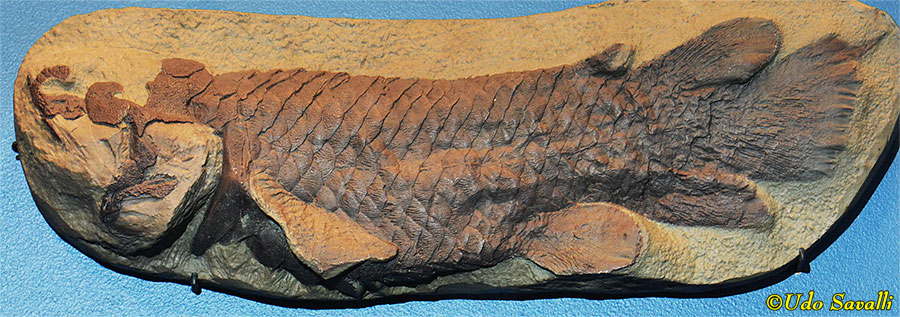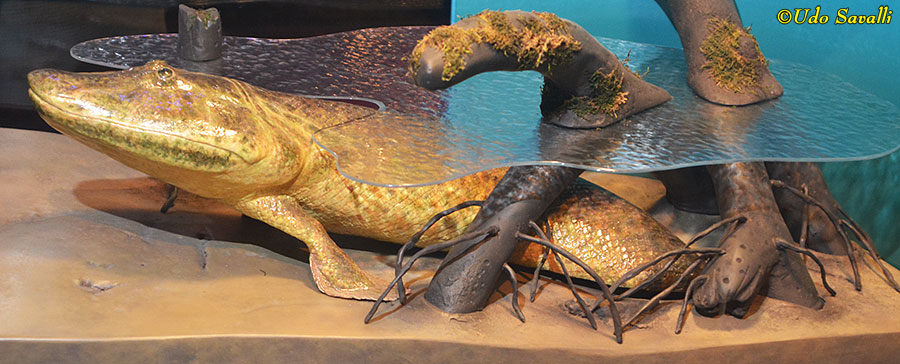Actinistia — Coelacanths
|
The bony fishes (Osteichtheys) have an internal skeleton of bone rather than cartilage. They have scales and mostly lack armor, although most of their skull bones are derived from the armor head plates of their ancestors.
There are two subdivisions of the bony fishes: the Sarcopterygii, or lobe-finned fishes, in which the paired fins are supported by a column of bon (compared to the ray-finned fishes, in which the fins are supported by more delicate fin rays). The 6 living species of sarcopterygian fishes are the coelacanths and lungfishes.
Most coelacanths can be easily recognized by their symmetric three-lobed tail, such as in this Coccoderma nudum
Taxonomy: Sarcopterygii; Actinistia; Laugiidae
Solnhofen Limestone, Germany
Late Jurassic Period, 150 Ma
Wyoming Dinosaur Center
|

|
|
|
This Caridosuctor populosum is an example of an extinct coelacanth. The two modern species are examples of "Lazarus species," organisms known from the fossil record before any living examples were discovered (the first in 1938).
Taxonomy: Sarcopterygii; Actinistia; Rhabdodermatidae
Central Montana
Carboniferous Period, Mississippian Epoch, Bear Gulch Limestone, 320 Ma
Museum of the Rockies, Montana
|

|
|
|
This fossil cast is of the primitive coelacanth fish Axelrodichthys araripensis
Taxonomy: Sarcopterygii ; Actinistia; Coelacanthidae
Brazil
Early Cretaceous Period, 110 Ma
Wyoming Dinosaur Center
|

|
|
|
Fossil of Macropomoides sp., which is closely related to the living species.
Taxonomy: Sarcopterygii ; Actinistia; Latimeriidae
Hjoula, Lebanon
Late Cretaceous, 110 Ma
Tucson Gem & Mineral Show
|

|
|
|
Although there are only two living species of coelacanths, their fossil record is much more diverse, with some such as this Allenypterus montanus having atypical body shapes.
Taxonomy: Sarcopterygii; Actinistia; Hadronectoridae
Central Montana
Carboniferous Period, Mississippian Epoch, Bear Gulch Limestone, 320 Ma
Museum of the Rockies, Montana
|

|
|
|
Another example of Allenypterus montanus.
Taxonomy: Sarcopterygii; Actinistia; Hadronectoridae
Montana
Carboniferous Period
Chicago Field Museum
|

|
|
|
Life model of Cardiosuctor populosum, a coelacanth.
Taxonomy: Sarcopterygii; Actinistia; Rhabdodermatidae
Carboniferous Period, Late Mississippian Epoch, 320 Ma; Montana
Museum of Ancient Life, Utah
|

|
|
Dipnoi — Lungfishes
|
There are 4 species of extant lungfishes, living in tropical swamps and rivers, but fossil species were much more diverse.
This is a cast of Uranolophus wyomingensis.
Taxonomy: Sarcopterygii; Dipnoi; Uranolophidae
Denver Museum of Science & Nature
|

|
|
|
Pentlandia macroptera lungfish.
Taxonomy: Sarcopterygii; Dipnoi; Dipteridae
Old Red Sandstone, Caithness, Scotland
Middle Devonian Period
Black Hills Institute Museum, South Dakota
|

|
|
|
Dipterus valenciennesi lungfish.
Taxonomy: Sarcopterygii; Dipnoi; Dipteridae
Scotland
Devonian Period
Chicago Field Museum
|

|
|
|
Holoptychius quebecensis lungfish.
Taxonomy: Sarcopterygii; Dipnoi; Holoptychiidae
Quebec, Canada
Devonian Period
Chicago Field Museum
|

|
|
|
Life model of Ceratodus sp. lungfish.
Taxonomy: Sarcopterygii; Dipnoi; Ceratodontiformes
Triassic Period
Arizona Museum of Natural History
|

|
|
|
Life model of Uranolophus wyomingensis lungfish.
Taxonomy: Sarcopterygii; Dipnoi; Uranolophina
Late Devonian Period
Museum of Ancient Life, Utah
|

|
|
Osteolepiformes & Tetrapodomorphs
|
The Osteolepiformes, such as this Gyroptychius agassizi, are an extinct group of sarcopterygian (lobe-finned) fishes that are the sister-group to the tetrapods (animals with four legs).
Taxonomy: Sarcopterygii; Osteolepiformes; Gyroptychiidae
Orkney, Scotland
Devonian Period
Black Hills Institute Museum, South Dakota
|

|
|
|
Life models of Osteolepis macrolepidotus.
Taxonomy: Sarcopterygii; Osteolepiformes; Osteolepidae
Scotland
Middle Devonian Period
Museum of Ancient Life, Utah
|

|
|
|
Eusthenopteron foordi is one of the best-known of the osteolepiformes with over 2000 specimens. It was also one of the largest, reaching up to 1.8 m in length.
Taxonomy: Sarcopterygii; Tetrapodamorpha;Tristichopteridae
Escuminac Formation, Quebec
Late Devonian Period, 365 Ma
Denver Museum of Science & Nature
|

|
|
|
Life model of Eusthenopteron sp., a large lobe-finned fish related to the tetrapods.
Taxonomy: Sarcopterygii; Tetrapodamorpha;Tristichopteridae
North America
Late Devonian Period
Wyoming Dinosaur Center
|

|
|
|
Life model of Panderichthys rhombolepis. This species probably lived in shallow water and may have hunted near the surface, as suggested by its flat skull and lack of dorsal fin. It is closely related to the tetrapods.
Taxonomy: Sarcopterygii; Tetrapodamorpha; Elpistostegalia; Panderichthyidae
Latvia
Middle Devonian Period, 3970 Ma
Museum of Ancient Life, Utah
|

|
|
|
Cast of holotype fossil of Tiktaalik roseae. The "fishapod" has characteristics intermediate between lobe-finned fishes (such as Panderichthys) and the tetrapods (amphibians), including gills, fin rays, the presence of a neck and wrists.
Taxonomy: Sarcopterygii; Tetrapodamorpha; Elpistostegalia
Canada
Late Devonian Period, 375 Ma
Chicago Field Museum
|

|
|
|
Life model of Tiktaalik roseae, dubbed the "fishapod".
Taxonomy: Sarcopterygii; Tetrapodamorpha; Elpistostegalia
Canada
Late Devonian Period, 375 Ma
Wyoming Dinosaur Center
|

|
|
|
Life model of the "fishapod" Tiktaalik roseae.
Taxonomy: Sarcopterygii; Tetrapodamorpha; Elpistostegalia
Canada
Late Devonian Period, 375 Ma
Chicago Field Museum
|

|
|
|




















